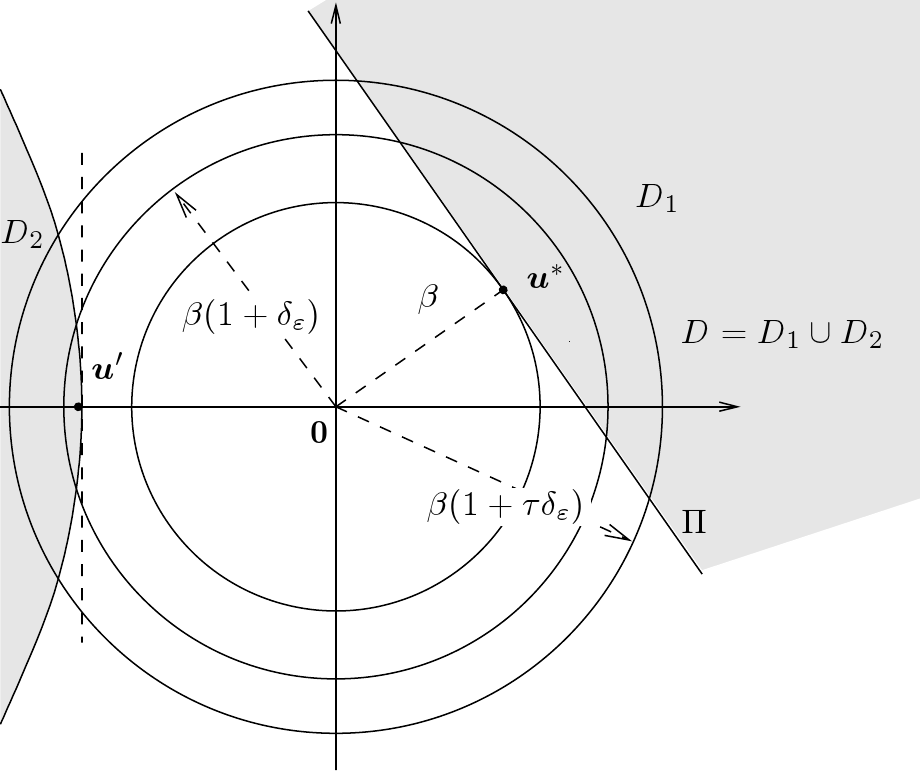Strong Maximum Test¶
(1)¶
may be evaluated with the FORM or SORM method.
the true design point, which means a global maximum point,
a strong design point, which means that there is no other local maximum located on the event boundary and which likelihood is slightly inferior to the design point one.
The vicinity of the Design Point is the arc of the sampled sphere which
is inside the half space which frontier is the linearized limit state
function at the Design Point: the vicinity is
the arc included in the half space .

The Strong Maximum Test proceeds as follows. The User selects the parameters:
the importance level
, where
,
the accuracy level
, where
,
the confidence level
where
or the number of points
used to sample the sphere. The parameters are deductible from one other.
set 1: all the points detected on the sampled sphere that are in
and outside the design point vicinity, with the corresponding value of the limit state function,
set 2: all the points detected on the sampled sphere that are in
and in the design point vicinity, with the corresponding value of the limit state function,
set 3: all the points detected on the sampled sphere that are outside
and outside the design point vicinity, with the corresponding value of the limit state function,
set 4: all the points detected on the sampled sphere that are outside
but in the vicinity of the design point, with the corresponding value of the limit state function.
Points are described by their coordinates in the -space.
3.0 |
0.01 |
2.0 |
0.9 |
62 |
|
3.0 |
0.01 |
2.0 |
0.99 |
124 |
|
3.0 |
0.01 |
4.0 |
0.9 |
15 |
|
3.0 |
0.01 |
4.0 |
0.99 |
30 |
|
3.0 |
0.1 |
2.0 |
0.9 |
130 |
|
3.0 |
0.1 |
2.0 |
0.99 |
260 |
|
3.0 |
0.1 |
4.0 |
0.9 |
26 |
|
3.0 |
0.1 |
4.0 |
0.99 |
52 |
|
5.0 |
0.01 |
2.0 |
0.9 |
198 |
|
5.0 |
0.01 |
2.0 |
0.99 |
397 |
|
5.0 |
0.01 |
4.0 |
0.9 |
36 |
|
5.0 |
0.01 |
4.0 |
0.99 |
72 |
|
5.0 |
0.1 |
2.0 |
0.9 |
559 |
|
5.0 |
0.1 |
2.0 |
0.99 |
1118 |
|
5.0 |
0.1 |
4.0 |
0.9 |
85 |
|
5.0 |
0.1 |
4.0 |
0.99 |
169 |
3.0 |
0.01 |
2.0 |
100 |
0.97 |
|
3.0 |
0.01 |
2.0 |
1000 |
1.0 |
|
3.0 |
0.01 |
4.0 |
100 |
1.0 |
|
3.0 |
0.01 |
4.0 |
1000 |
1.0 |
|
3.0 |
0.1 |
2.0 |
100 |
0.83 |
|
3.0 |
0.1 |
2.0 |
1000 |
1.0 |
|
3.0 |
0.1 |
4.0 |
100 |
1.0 |
|
3.0 |
0.1 |
4.0 |
1000 |
1.0 |
|
5.0 |
0.01 |
2.0 |
100 |
0.69 |
|
5.0 |
0.01 |
2.0 |
1000 |
1.0 |
|
5.0 |
0.01 |
4.0 |
100 |
1.0 |
|
5.0 |
0.01 |
4.0 |
1000 |
1.0 |
|
5.0 |
0.1 |
2.0 |
100 |
0.34 |
|
5.0 |
0.1 |
2.0 |
1000 |
0.98 |
|
5.0 |
0.1 |
4.0 |
100 |
0.93 |
|
5.0 |
0.1 |
4.0 |
1000 |
0.99 |
As the Strong Maximum Test involves the computation of values
of the limit state function, which is computationally intensive, it is
interesting to have more than just an indication about the quality of
. In fact, the test gives some information about the
trace of the limit state function on the sphere of radius
centered on the origin of the
-space. Two cases can be distinguished:
- Case 1: set 1 is empty. We are confident on the fact that
is a design point verifying the hypothesis according to which most of the contribution of
is concentrated in the vicinity of
. By using the value of the limit state function on the sample
, we can check if the limit state function is reasonably linear in the vicinity of
, which can validate the second hypothesis of FORM.
If the behavior of the limit state function is not linear, we can decide to use an importance sampling version of the Monte Carlo method for computing the probability of failure. However, the information obtained through the Strong Max Test, according to whichis the actual design point, is quite essential : it allows one to construct an effective importance sampling density, e.g. a multidimensional Gaussian distribution centered on
.
Case 2: set 1 is not empty. There are two possibilities:
We have found some points that suggest that
is not a strong maximum, because for some points of the sampled sphere, the value taken by the limit state function is slightly negative;
- We have found some points that suggest that
is not even the global maximum, because for some points of the sampled sphere, the value taken by the limit state function is very negative.
In the first case, we can decide to use an importance sampling version of the Monte Carlo method for computing the probability of failure, but with a mixture of e.g. multidimensional gaussian distributions centered on thein
(refer to ). In the second case, we can restart the search of the design point by starting at the detected
.
 OpenTURNS
OpenTURNS